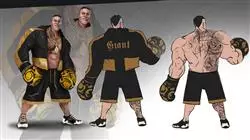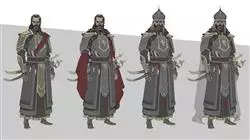University certificate
The world's largest faculty of video games”
Introduction to the Program
You will hone your skills in 2D Animation, which preserves the elegance and warmth of traditional techniques, becoming a creative platform rich in narrative and stylistic possibilities"

2D Animation offers a wide range of benefits, not least because of its classic and timeless visual style, which allows for the creation of characters and environments, capturing the viewer's imagination in a charming way. In addition, its apparent simplicity facilitates complex storytelling in an accessible way, allowing for a deeper connection with the audience. The versatility of this format allows experimentation with visual and expressive styles, giving creators extraordinary freedom.
As a result, this Professional master’s degree in 2D Animation is created, which presents a comprehensive syllabus that will include modules designed to qualify designers in the facets of two-dimensional animation. Therefore, professionals will address the fundamentals of graphic design, understanding how the proper use of lines, shapes and colors contributes to the visual narrative in animation. In addition, they will delve into the basic principles that govern movement and expression in this format, creating convincing animated sequences.
Furthermore, the program will explore current technologies, providing knowledge of software and digital techniques essential for the creation of contemporary 2D animations. To this must be added a deep understanding of specific aspects, from character development to the application of advanced techniques.
Similarly, graduates will be prepared to plan animation projects effectively, considering aspects such as scripting and production design, and then focus on project execution, applying their knowledge in the creation of complete animations. Finally, students will be equipped with skills to perfect and promote their creations in the market, understanding the importance of marketing and commercialization in this industry.
As such, the educational program will offer a unique opportunity by presenting a fully online and flexible modality. This approach will give students an extended freedom to organize their study schedule, enabling them to reconcile their daily personal and professional responsibilities in a more efficient way.
2D Animation is easily adaptable to various platforms, from television to social media, making it an effective tool for reaching audiences of all ages. Enroll now!”
This Professional master’s degree in 2D Animation contains the most complete and up-to-date program on the market. The most important features include:
- The development of case studies presented by experts in 2D Animation
- The graphic, schematic and practical contents of the book provide theoretical and practical information on those disciplines that are essential for professional practice
- Practical exercises where self-assessment can be used to improve learning
- Its special emphasis on innovative methodologies
- Theoretical lessons, questions to the expert, debate forums on controversial topics, and individual reflection assignments
- Content that is accessible from any fixed or portable device with an Internet connection
You will delve into the key concepts that govern movement in animation, such as anticipation, overload and action tracking, through the revolutionary Relearning methodology"
The program’s teaching staff includes professionals from the industry who contribute their work experience to this program, as well as renowned specialists from leading societies and prestigious universities.
The multimedia content, developed with the latest educational technology, will provide the professional with situated and contextual learning, i.e., a simulated environment that will provide immersive education programmed to learn in real situations.
This program is designed around Problem-Based Learning, whereby the professional must try to solve the different professional practice situations that arise during the course. For this purpose, the students will be assisted by an innovative interactive video system created by renowned and experienced experts.
You will combine artistic tradition with digital technologies, approaching animation projects from multiple creative perspectives"

You will refine and promote your creations in the market, understanding the importance of marketing and commercialization in the 2D Animation industry"
Why study at TECH?
TECH is the world’s largest online university. With an impressive catalog of more than 14,000 university programs available in 11 languages, it is positioned as a leader in employability, with a 99% job placement rate. In addition, it relies on an enormous faculty of more than 6,000 professors of the highest international renown.

Study at the world's largest online university and guarantee your professional success. The future starts at TECH”
The world’s best online university according to FORBES
The prestigious Forbes magazine, specialized in business and finance, has highlighted TECH as “the world's best online university” This is what they have recently stated in an article in their digital edition in which they echo the success story of this institution, “thanks to the academic offer it provides, the selection of its teaching staff, and an innovative learning method aimed at educating the professionals of the future”
A revolutionary study method, a cutting-edge faculty and a practical focus: the key to TECH's success.
The most complete study plans on the university scene
TECH offers the most complete study plans on the university scene, with syllabuses that cover fundamental concepts and, at the same time, the main scientific advances in their specific scientific areas. In addition, these programs are continuously being updated to guarantee students the academic vanguard and the most in-demand professional skills. In this way, the university's qualifications provide its graduates with a significant advantage to propel their careers to success.
TECH offers the most comprehensive and intensive study plans on the current university scene.
A world-class teaching staff
TECH's teaching staff is made up of more than 6,000 professors with the highest international recognition. Professors, researchers and top executives of multinational companies, including Isaiah Covington, performance coach of the Boston Celtics; Magda Romanska, principal investigator at Harvard MetaLAB; Ignacio Wistumba, chairman of the department of translational molecular pathology at MD Anderson Cancer Center; and D.W. Pine, creative director of TIME magazine, among others.
Internationally renowned experts, specialized in different branches of Health, Technology, Communication and Business, form part of the TECH faculty.
A unique learning method
TECH is the first university to use Relearning in all its programs. It is the best online learning methodology, accredited with international teaching quality certifications, provided by prestigious educational agencies. In addition, this disruptive educational model is complemented with the “Case Method”, thereby setting up a unique online teaching strategy. Innovative teaching resources are also implemented, including detailed videos, infographics and interactive summaries.
TECH combines Relearning and the Case Method in all its university programs to guarantee excellent theoretical and practical learning, studying whenever and wherever you want.
The world's largest online university
TECH is the world’s largest online university. We are the largest educational institution, with the best and widest online educational catalog, one hundred percent online and covering the vast majority of areas of knowledge. We offer a large selection of our own degrees and accredited online undergraduate and postgraduate degrees. In total, more than 14,000 university degrees, in eleven different languages, make us the largest educational largest in the world.
TECH has the world's most extensive catalog of academic and official programs, available in more than 11 languages.
Google Premier Partner
The American technology giant has awarded TECH the Google Google Premier Partner badge. This award, which is only available to 3% of the world's companies, highlights the efficient, flexible and tailored experience that this university provides to students. The recognition as a Google Premier Partner not only accredits the maximum rigor, performance and investment in TECH's digital infrastructures, but also places this university as one of the world's leading technology companies.
Google has positioned TECH in the top 3% of the world's most important technology companies by awarding it its Google Premier Partner badge.
The official online university of the NBA
TECH is the official online university of the NBA. Thanks to our agreement with the biggest league in basketball, we offer our students exclusive university programs, as well as a wide variety of educational resources focused on the business of the league and other areas of the sports industry. Each program is made up of a uniquely designed syllabus and features exceptional guest hosts: professionals with a distinguished sports background who will offer their expertise on the most relevant topics.
TECH has been selected by the NBA, the world's top basketball league, as its official online university.
The top-rated university by its students
Students have positioned TECH as the world's top-rated university on the main review websites, with a highest rating of 4.9 out of 5, obtained from more than 1,000 reviews. These results consolidate TECH as the benchmark university institution at an international level, reflecting the excellence and positive impact of its educational model.” reflecting the excellence and positive impact of its educational model.”
TECH is the world’s top-rated university by its students.
Leaders in employability
TECH has managed to become the leading university in employability. 99% of its students obtain jobs in the academic field they have studied, within one year of completing any of the university's programs. A similar number achieve immediate career enhancement. All this thanks to a study methodology that bases its effectiveness on the acquisition of practical skills, which are absolutely necessary for professional development.
99% of TECH graduates find a job within a year of completing their studies.
Professional Master's Degree in 2D Animation
Discover the exciting world of digital art and cartoons with TECH Global University's Professional Master's Degree in 2D Animation, specializing in the fascinating field of video games. This innovative program will immerse you in the creative and technical process of animation, giving you the skills you need to excel in the digital entertainment industry. With the online classes we offer, you will access a quality education from anywhere, adapting your studies to your schedule and pace of life. Our pedagogical approach is based on the combination of theory and practice, allowing you to immediately apply what you learn in your professional career. This postgraduate program focuses specifically on the exciting field of video games, where animation plays a crucial role in creating stunning and immersive visual experiences. You will learn the most advanced techniques to bring to life characters, scenarios and movements that will captivate players and elevate the quality of any video game development project.
Drive your goals with this postgraduate program in 2D animation
At TECH Global University, we have a faculty made up of animation and video game industry professionals who will guide you in exploring the latest trends and technological tools. You will gain in-depth knowledge in specialized software and develop a portfolio that will highlight your skills to future employers and collaborators in the industry. Upon graduating from our Professional Master's Degree in 2D Animation, you will be prepared to face the creative and technical challenges of video game animation. You will be able to contribute to the development of innovative projects, offering a differential value in a market that demands highly trained professionals. Take the first step towards a successful career in the world of digital art in motion, enroll in the Professional Master's Degree in 2D Animation at TECH Global University and open the doors to a future full of possibilities.







